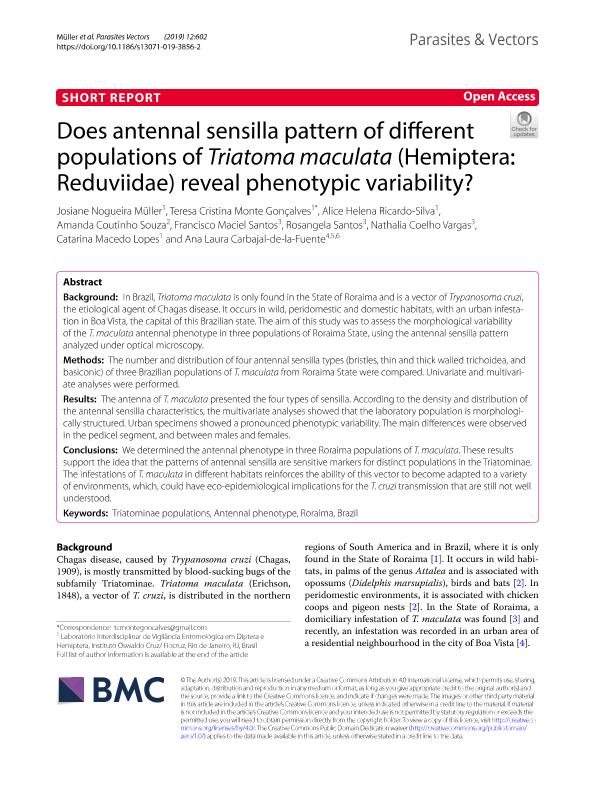Mostrar el registro sencillo del ítem
dc.contributor.author
Nogueira Müller, Josiane
dc.contributor.author
Monte Gonçalves, Teresa
dc.contributor.author
Ricardo Silva, Alice Helena
dc.contributor.author
Coutinho Souza, Amanda
dc.contributor.author
Maciel Santos, Francisco
dc.contributor.author
Santos, Rosangela
dc.contributor.author
Coelho Vargas, Nathalia
dc.contributor.author
Macedo Lopes, Catarina
dc.contributor.author
Carbajal de la Fuente, Ana Laura

dc.date.available
2022-10-27T11:58:26Z
dc.date.issued
2019-12
dc.identifier.citation
Nogueira Müller, Josiane; Monte Gonçalves, Teresa; Ricardo Silva, Alice Helena; Coutinho Souza, Amanda; Maciel Santos, Francisco; et al.; Does antennal sensilla pattern of different populations of Triatoma maculata (Hemiptera: Reduviidae) reveal phenotypic variability?; BioMed Central; Parasites and Vectors; 12; 1; 12-2019; 10-15
dc.identifier.issn
1756-3305
dc.identifier.uri
http://hdl.handle.net/11336/175122
dc.description.abstract
Background: In Brazil, Triatoma maculata is only found in the State of Roraima and is a vector of Trypanosoma cruzi, the etiological agent of Chagas disease. It occurs in wild, peridomestic and domestic habitats, with an urban infestation in Boa Vista, the capital of this Brazilian state. The aim of this study was to assess the morphological variability of the T. maculata antennal phenotype in three populations of Roraima State, using the antennal sensilla pattern analyzed under optical microscopy. Methods: The number and distribution of four antennal sensilla types (bristles, thin and thick walled trichoidea, and basiconic) of three Brazilian populations of T. maculata from Roraima State were compared. Univariate and multivariate analyses were performed. Results: The antenna of T. maculata presented the four types of sensilla. According to the density and distribution of the antennal sensilla characteristics, the multivariate analyses showed that the laboratory population is morphologically structured. Urban specimens showed a pronounced phenotypic variability. The main differences were observed in the pedicel segment, and between males and females. Conclusions: We determined the antennal phenotype in three Roraima populations of T. maculata. These results support the idea that the patterns of antennal sensilla are sensitive markers for distinct populations in the Triatominae. The infestations of T. maculata in different habitats reinforces the ability of this vector to become adapted to a variety of environments, which, could have eco-epidemiological implications for the T. cruzi transmission that are still not well understood.
dc.format
application/pdf
dc.language.iso
eng
dc.publisher
BioMed Central

dc.rights
info:eu-repo/semantics/openAccess
dc.rights.uri
https://creativecommons.org/licenses/by/2.5/ar/
dc.subject
ANTENNAL PHENOTYPE
dc.subject
BRAZIL
dc.subject
RORAIMA
dc.subject
TRIATOMINAE POPULATIONS
dc.subject.classification
Zoología, Ornitología, Entomología, Etología

dc.subject.classification
Ciencias Biológicas

dc.subject.classification
CIENCIAS NATURALES Y EXACTAS

dc.title
Does antennal sensilla pattern of different populations of Triatoma maculata (Hemiptera: Reduviidae) reveal phenotypic variability?
dc.type
info:eu-repo/semantics/article
dc.type
info:ar-repo/semantics/artículo
dc.type
info:eu-repo/semantics/publishedVersion
dc.date.updated
2022-10-27T10:22:47Z
dc.journal.volume
12
dc.journal.number
1
dc.journal.pagination
10-15
dc.journal.pais
Reino Unido

dc.journal.ciudad
Londres
dc.description.fil
Fil: Nogueira Müller, Josiane. Instituto Oswaldo Cruz; Brasil
dc.description.fil
Fil: Monte Gonçalves, Teresa. Instituto Oswaldo Cruz; Brasil
dc.description.fil
Fil: Ricardo Silva, Alice Helena. Instituto Oswaldo Cruz; Brasil
dc.description.fil
Fil: Coutinho Souza, Amanda. Instituto Oswaldo Cruz; Brasil
dc.description.fil
Fil: Maciel Santos, Francisco. No especifíca;
dc.description.fil
Fil: Santos, Rosangela. No especifíca;
dc.description.fil
Fil: Coelho Vargas, Nathalia. No especifíca;
dc.description.fil
Fil: Macedo Lopes, Catarina. Instituto Oswaldo Cruz; Brasil
dc.description.fil
Fil: Carbajal de la Fuente, Ana Laura. Dirección Nacional de Institutos de Investigación. Administración Nacional de Laboratorios e Institutos de Salud. Centro Nacional de Diagnóstico e Investigaciones Endemo-epidémicas; Argentina. Consejo Nacional de Investigaciones Científicas y Técnicas. Oficina de Coordinación Administrativa Ciudad Universitaria. Instituto de Ecología, Genética y Evolución de Buenos Aires. Universidad de Buenos Aires. Facultad de Ciencias Exactas y Naturales. Instituto de Ecología, Genética y Evolución de Buenos Aires; Argentina
dc.journal.title
Parasites and Vectors

dc.relation.alternativeid
info:eu-repo/semantics/altIdentifier/url/https://parasitesandvectors.biomedcentral.com/articles/10.1186/s13071-019-3856-2
dc.relation.alternativeid
info:eu-repo/semantics/altIdentifier/doi/http://dx.doi.org/10.1186/s13071-019-3856-2
Archivos asociados
